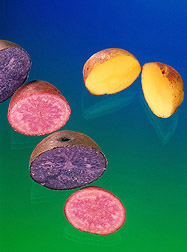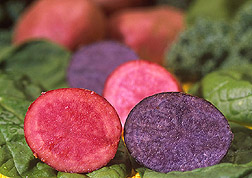Colorful Potatoes Offer Nutrition, Variety
|
|
|
|
Orange mashed potatoes? Purple french fries? Potato dishes of the future could be healthier, tastier, and more colorful if breeders incorporate diverse Andean potatoes.
"All potatoes originated in South America, but there are many variations that we don't typically see here in the United States," says ARS geneticist Charles R. Brown. "Potatoes with orange, red, or purple flesh may provide health benefits and new flavors," he says. Brown works at the ARS Vegetable and Forage Crops Production Research Unit in Prosser, Washington. All potatoes are a good source of complex carbohydrates, potassium, vitamin C, folic acid, and iron. Brown has made dozens of breeding crosses to examine additional health benefits in colored varieties. "The pigments that produce the colors may also function as antioxidants in the human diet," Brown says. Antioxidants are believed to aid in preventing certain cancers and types of blindness, as well as improving cardiovascular health. |
|
|
Brown has developed orange-fleshed potatoes with up to four times the antioxidants zeaxanthin and lutein as white potatoes. In a blindfolded taste test of boiled, diced potatoes, consumers preferred the flavor of the orange potatoes to that of the white ones. Consumers may already know of some red- or purple-fleshed potatoes, occasionally sold through organic cooperatives. But Brown has developed potatoes with these darker colors that have more than four times the antioxidant potential than current commercial varieties. The potatoes also score well against other foods in a standard measure for antioxidant capacity, a laboratory test called ORAC, or oxygen radical absorbance capacity. (See "Can Foods Forestall Aging?"Agricultural Research, February 1999, pp. 14–17.) Brown's red- and purple-fleshed potatoes achieved ORAC scores comparable to brussels-sprouts, kale, or spinach. Brown says that before the colored potatoes become available commercially, important agronomic traits need to be verified or incorporated, such as appealing skin appearance, reasonable yield and disease resistance, and low concentrations of bitterness compounds. Some of his experimental breeding lines may be ready for commercial testing once enough seed is available. "There is tremendous interest from growers," Brown says. "These colored varieties are seen as a radically new type of potato for a previously untapped market," he notes. "Americans love their potatoes. Giving them additional reasons to include potatoes in their diet is a plan that's likely to succeed."—By Kathryn Barry Stelljes, Agricultural Research Service Information Staff. This research is part of Plant, Microbial, and Insect Genetic Resources, Genomics, and Genetic Improvement, an ARS National Program (#301) described on the World Wide Web at http://www.nps.ars.usda.gov. Charles R. Brown is at the USDA-ARS Vegetable and Forage Crops Production Research Unit, 24106 N. Bunn Rd., Prosser, WA 99350-9687; phone (509) 786-9252, fax (509) 786-9277. |
|
"Colorful Potatoes Offer Nutrition, Variety" was published in the October 2001 issue of Agricultural Research magazine. |
|








